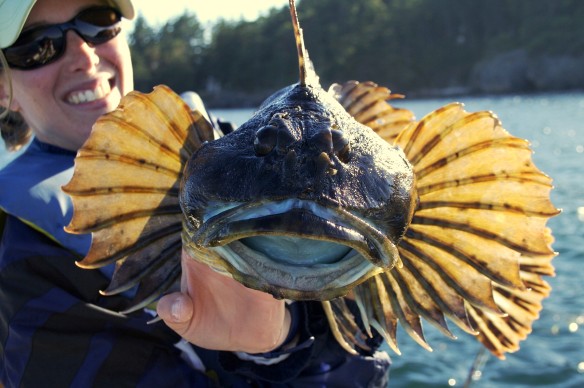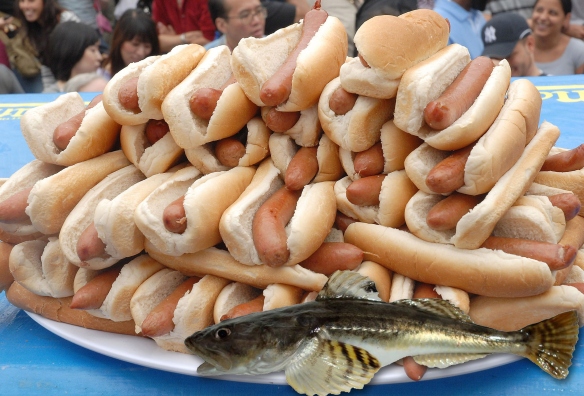by Anne Beaudreau
Sculpins get a bad rap. Scorned by anglers and scoffed at by scientists, these bottom-dwellers have a host of unflattering nicknames, from “bullheads” to “double uglies.” The array of adjectives used to describe them is reliably disparaging: ugly, useless, homely, drab, and a nuisance.
All that trash talk is pretty unfair, if you ask me. Sculpins are not only a fascinating group of abundant, ubiquitous fishes but they may very well be the silent rulers of coastal marine ecosystems. To show you why, I bring you three vignettes about the wonderful world of sculpins.
The red Irish lord is a real beauty.
One. A Thing of Beauty
Sculpins come in all shapes, sizes, and colors. They have lovely and bizarre names, like Myoxocephalus polyacanthocephalus, the scientific name for great sculpin that roughly translates to “muscle-head spiny-head.” Most have spines protruding from their cheeks—shaped like antlers, spikes, combs, and clubs—to protect them from the mouths of predators. They need that protection because, truth be told, most sculpins are less than a foot long. But a few can give anglers a run for their money. The biggest sculpin – the cabezon – can reach sizes of 3 feet and 30 pounds1. I have heard stories of aggressive cabezon head-butting divers who came too close to the egg masses they were guarding. Some sculpins are quite beautiful and lavishly decorated with colorful designs, like the red Irish lord, and others are adorable squat little creatures, like the buffalo sculpin. Sculpins have been inspiration for both art and beer.

- Ragga shows off an adorable baby sculpin that was caught in a beach seine near Juneau, Alaska. Photo by Emily Whitney.

Cabezon were fun to catch in the San Juan Islands, Washington. They put up a fight and are tasty too. Photo by Aaron Dufault.

Just this week we were fortunate to see this beauty, a crested sculpin that was hanging out in some algae growth on a crab pot line. Photo by Anne Beaudreau.

I spotted these beautiful Tsimshian dance leggings adorned with sculpins at the Anchorage Museum.
Two. Eat or Be Eaten
Wherever they live, sculpins are leading actors in an ecological drama that unfolds every day, where all creatures must eat or be eaten. They play a central role in nearshore ecosystems as both prey and predators. In my graduate research, I found that sculpins were one of the most common diet items for lingcod, a large toothy predator living in kelp forests of the North Pacific. Some small sculpin species serve another important role for lingcod—they act as cleaners, picking off parasites from inside the open mouth of the lingcod itself! It is a dangerous job and one that sometimes lands the helpful sculpin at the bottom of a predator’s stomach.

- Buffalo sculpins make up for their small stature with intimidating spines that deter predators. Photo by Aaron Dufault.
Sculpins may make a tasty snack for larger creatures, including people, but they are also terrific predators in their own right. Most sculpins are basically a big mouth with a tail attached. One of the species we’ve been studying, Pacific staghorn sculpin, is armed with antler-like spines on either side of its face and can eat other fish that are half of its own length. Can you imagine swallowing a 2- to 3-foot long animal alive and whole? What a beast! Staghorn sculpins are omnivores, feasting on everything from baby mussels the size of a poppy seed to carcasses of spawning adult salmon. Just like toddlers, staghorn sculpins can be picky eaters too, sometimes chomping only the siphons off the tops of unsuspecting clams. Some staghorn sculpins even have an expensive taste for caviar: we once collected a staghorn sculpin that had gorged itself on 85 salmon eggs!

- There is no creature so bold as a hungry sculpin. Photo by Emily Whitney.

If you’ve ever wondered which intertidal species would win a hotdog eating contest, look no further—it’s the staghorn sculpin.
Three. Abundant and Adaptable
Sculpins are everywhere. They are found throughout the world, in both freshwater and saltwater. There are over 750 species of sculpin and around 300 species in the family Cottidae alone2, which is the group of sculpins that I know best. Here in Juneau, sculpins dominate fish communities in the nearshore. About 40% of the fish we catch beach seining near river deltas are none other than the Pacific staghorn sculpin. Many sculpins live in harsh, dynamic environments like the intertidal. Tidepool sculpins, tiny creatures no longer than your finger, have a strong urge to stay close to home. Some have been observed in a single tidepool for more than a year3. If they are moved from their home pool, these wee sculpins can find their way back, even after being on an extended vacation (i.e., moved to an “unnatural environment” by scientists for 6 months)3. As for staghorn sculpins, there is so much we still don’t know about where they live, how far they move, or how many of them are out there, chowing down on a smorgasbord of salty snacks. Staghorns live in the sea, but can withstand freshwater and can even breath air to some extent4. Given the challenging environment they navigate every day, perhaps sculpins just might be the most equipped of all to deal with our rapidly changing oceans.
While I may not have convinced you that sculpins are at least as cool as salmon, I hope that you have gained a little more appreciation for them. If nothing else, show those bullheads a little respect. They might take over the world someday, in all their air-breathing, spine-wielding glory. Don’t say I didn’t warn you.

- Behold, the glorious Pacific staghorn sculpin. Photo by Doug Duncan.
Bonus sculpin fact: Some sculpins can change the shape of their skulls to fit through tiny spaces! Ellen Marsden of the University of Vermont told the story of how she and a student made this amazing discovery: https://www.uvm.edu/uvmnews/news/faculty-feature-ellen-marsden
—
1 Froese, R., and D. Pauly, eds. 2017. Scorpaenichthys marmoratus in FishBase. www.fishbase.org. Accessed September 2017.
2 Mecklenburg, C.W., T.A. Mecklenburg, and L.K. Thorsteinson. 2002. Fishes of Alaska. Am. Fish. Soc., Bethesda, MD.
3 Green, J.M. 1971. High tide movements and homing behaviour of the tidepool sculpin Oligocottus maculosus. Journal of the Fisheries Research Board of Canada 28(3): 383-389.
4 Love, M. 1996. Probably More Than You Want to Know About the Fishes of the Pacific Coast. Really Big Press, Santa Barbara, California.



What a great description of sculpin. I have a renewed appreciation for this funny looking fish.
LikeLike
Thanks, Lisa! We’re glad you’re in the sculpin fan club.
LikeLike
Let me know if you’d like pdfs of my sculpin papers
LikeLike
Sure, please send them our way! Email contact is listed on the homepage.
LikeLike
Thanks so much for this article. Have you or do you know of anyone that has studied the egg laying – reproductive habits of Staghorn Sculpins? On three different occasions now I have filmed a raven digging up a Staghorn and eating its eggs which were in a horse clam shell. A friend also once photographed one in the intertidal area, buried with its head above the sand with a horse clam shell on it and eggs underneath it. Here is a video of one of the events I filmed https://www.naturebob.com/raven-digs-staghorn-sculpin-and-eats-its-eggs.
Thanks,
Bob Armstrong
LikeLike
Apologies for the delayed response, Bob! I absolutely love your videos and have learned a lot from your work. From our literature searches, studies on staghorn sculpin reproductive biology and behavior are slim to none. This would be fascinating to learn more about. – Anne
LikeLike